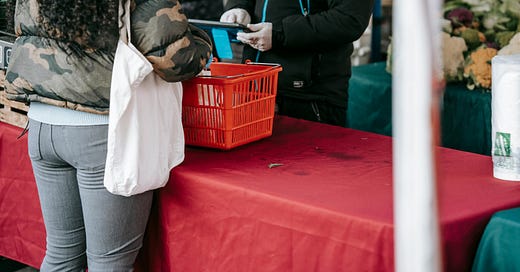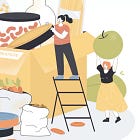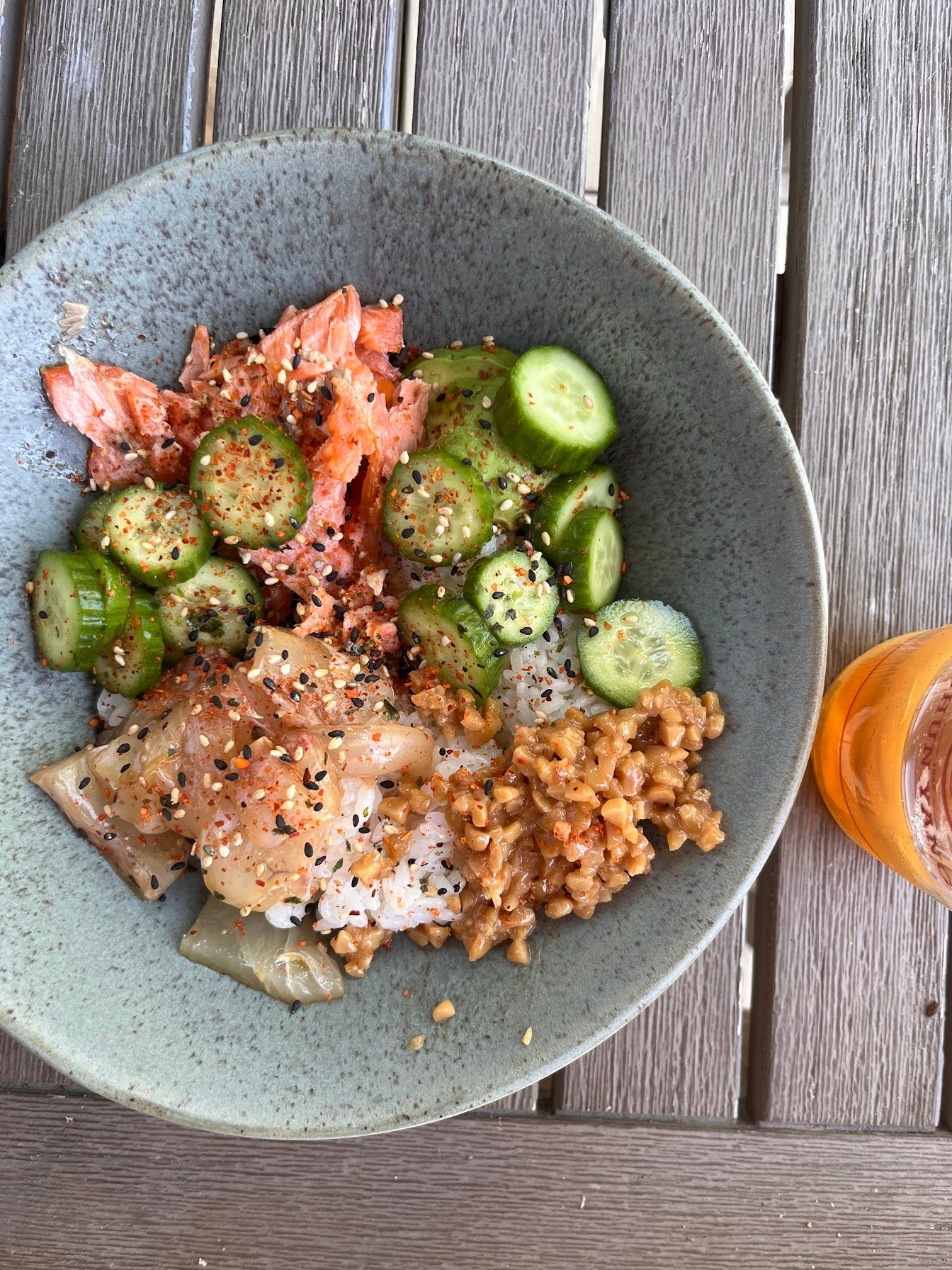Cycles of Asking for More
On the links between fundraising, growth, and the stories we tell ourselves.
Earlier this month, I presented my capstone project to a panel of my peers, and officially graduated from my Food Studies Masters program. This brought the last two years of studying, connecting with other food scholars, and deepening my knowledge of food policy and food as medicine to a satisfying close.
Historically, I’ve worked as a grant writer and in nonprofit development, and this work has kept me afloat as a freelancer during my program. As anyone who works in these spaces will know, nonprofit funding follows a cycle: arcs of busyness and a flurry of deadlines followed by quiet while you wait for decisions to be made about your request. I feel too that I’m at the end of one cycle and the start of another; the end of my time as a student (with its flurry of deadlines) and into the quiet wait of what comes next.
While I figure that out, I feel fortunate to fall back on the skillset of development and fundraising that’s supported me thus far. But this knowledge is often gatekept by the fundraising industry (and it is an industry). Despite the amount of money seemingly flowing into food as medicine, many folks I’ve spoken to still struggle to navigate effective fundraising and partnership development. This knowledge and experience gap comes at a time when it’s especially critical for food as medicine advocates to have effective tools to drive innovation forward. With an election underway and the Farm Bill ( a huge piece of legislation that will have massive impacts on the future of our food system) still in limbo, there is a huge amount at stake in the future of our food system.
At the core of these challenges is the fact that food ultimately costs money. And while U.S. food prices have historically been relatively low, prices have gone up significantly in the last few years. This makes food even less accessible to those already struggling with low incomes, while also making it more difficult to potentially fund programs that utilize and distribute food as well.
According to the Rockefeller Foundation, “the way Americans eat and produce food costs nearly $2 trillion in health and environmental expenditures alone—and that cost disproportionately burdens communities of color.”1 Sweeping federal food policy shifts are likely the only mechanism we currently have in our arsenal to address these challenges on a national scale, which is why legislation like the Farm Bill is so important. But even the Farm Bill won’t be a golden ticket; implementation of policies at the state and city level are just as key, and this is where many of the funding challenges begin to make themselves apparent.
How much funding ultimately trickles down to the grassroots organizations doing on-the-ground work is a function of both their ability to apply for grants and the general availability of funds. The former challenge is often exacerbated by the fact that good grant writers can be expensive and their high demand means they can often choose to work for organizations that can pay them more or give them better benefits. This keeps effective fundraisers from the organizations that often need them the most.
The latter challenge is due to the lack of larger structural mechanisms that could move the effects of food as medicine outside of the nonprofit field and integrate them more directly into our health and public health care systems. Unlike traditional healthcare services that are documented and billed through medical records, services like culinary medicine or medically tailored foods still often lack standardized billing codes. This means patients usually pay out of pocket, or these services need to be offered at free or low-cost through fundraising efforts completed by nonprofits.
One of the potential solutions that’s been suggested for this challenge is the role of tech startups and venture capital investing in new models and companies that can demonstrate efficacy. Startups in the nutritional food space are growing at a rate of over 10% annually, with food as medicine companies in particular gaining traction. These companies focus on buzzy new approaches such as precision nutrition, AI-powered recommendations, and expanded delivery services, and they promote the idea that capital-driven innovation can lead to improved health. Advocates point to explosive growth and the potential of new technologies like AI to help develop customized nutrition plans or targeted solutions.
While I do think that VC and tech companies have a role to play in the food as medicine revolution, I’m not sure they can or should be viewed as the saviors many seem willing to credit them as. Technology offers us tools for expanding initiatives, improving data tracking, and perhaps streamlining transportation and distribution, but ultimately these organizations are focused on profits first. Food as medicine may be big business now, but what happens when it falls out of fashion for the next trend? We need a longer view and a deep, committed investment in food infrastructure and access that’s prepared to continue even when the funding priorities shift.

Critique aside, it’s worth noting that VC and technology does have a role to play in potentially democratizing food as medicine by streamlining otherwise challenging processes, such as smoothing distribution pathways or supporting more efficient cold-chain storage. Notably, the tech space is able to operate outside of the nonprofit fundraising cycle; investments could in theory support the build of a sustainable organization over several years. And the fundraising cycle is grueling, demanding extensive relationship-building, meticulous record-keeping, and the ability to articulate the benefits of investing in a program. It’s clear that the system we operate in, sometimes referred to as the nonprofit industrial complex, is cracking.
The nonprofit industrial complex is a phrase used to describe the cycle nonprofits go through with seeking funding, expanding their impact, and then seeking additional funding to maintain or sustain that impact. It also refers to the fact that nonprofits often are required to access or request funding from sources that may be contributors to the very problems they are trying to address. Wealthy individuals and corporations make donations to support nonprofits, but these donations also create benefits for the donor. Donations to foundations in particular are tax deductible, which establishes private foundations as a legal way to avoid taxes on large portions of wealth and cuts revenue for public social services.
So the biggest challenge for many nonprofits is that the system they operate within is itself unsustainable. We have to constantly seek more funding, expand our programs to serve more people, and then need even more funding to sustain that expansion. Despite the mission of every nonprofit I’ve worked with to “solve these challenges so we no longer have jobs,” I have never seen this realized in practice. This is part of a larger systemic cycle of investment, band-aid solutions, and short-term fixes operating in an environment not designed for long-term success.
The only way to break these cycles is to develop policies and invest in larger social and physical infrastructure that support sustainable outcomes. If we don’t want people to go hungry, we must invest in policies that make food more accessible, reduce food waste, and improve quality of life by alleviating poverty. Solutions like universal basic income, subsidized school meals, and community food initiatives such as gardens and edible food infrastructure would make a significant difference.

I’ve been a grant-writer for a long time, and I have a love-hate relationship with this work. On the one hand, I get to tell stories about projects I care about, and convince others that they should do the same. When I’m successful, those projects get funded and can reach even more people. On the other hand, I’m bound by the same cycles that I find frustrating and unsustainable. By participating in it, I implicitly endorse it. As I think about the cycles I’m ending and the new ones I want to participate in, I’m still grappling with what kind of future I want to envision for this field and for myself. Ideally it’s one with balance: between work and play, tactile and intellectual experience, and work that is powerful but not overwhelming or that leads to burnout. It feels like a lot to ask, but I also know that the arc of this discovery period is long. I hope the same is true for food as medicine as well.
Reading
After reading several chapters from it for my Food and Culture class, I caved and bought the actual volume of Food and Culture: A Reader, edited by by Carole Counihan, Penny Van Esterik, and Alice Julier. It definitely leans more on the academic side, but the pieces contained within are fascinating deep dives into history, food politics, globalism, and gender identity as it relates to food.
Cooking
My partner was having a bit of an inflammation spell, so I whipped up this lovely rice bowl for us both, featuring natto, grilled salmon collar, soy marinated amberjack, quick pickled cucumbers. It finally feels like warm weather eating is here to stay!
Rockefeller Foundation Report - The Trust Cost of Food. 2021. https://www.rockefellerfoundation.org/report/true-cost-of-food-measuring-what-matters-to-transform-the-u-s-food-system/






